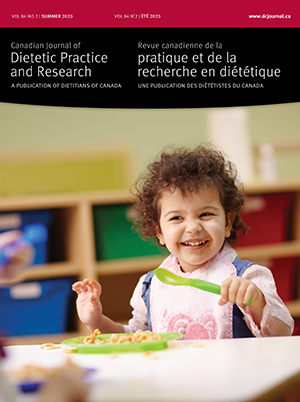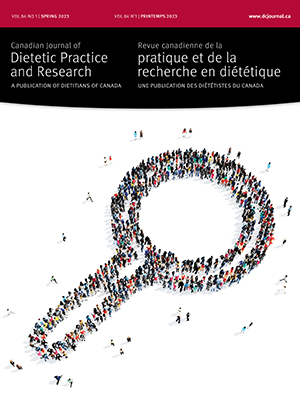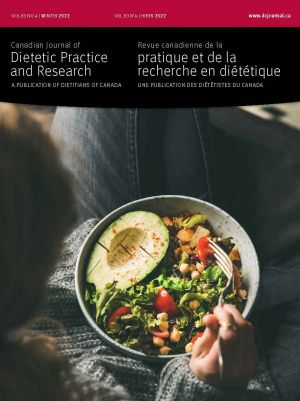Volume 66 • Number 3 • September 2005
Chair’s Message
Editor’s Message
Research
The validity was determined for Minimum Data Set (MDS) 2.0 oral/nutrition status (Section K) items, used to identify long-term care residents at nutritional risk. A registered dietitian assessed 128 long-term care residents using standardized procedures, and used clinical judgment to provide a nutritional risk rating. Registered nursing staff completed the MDS assessments. Bivariate tests of association were used to assess the relationship between the dietitian rating and each Section K item. The sensitivity (Se) and specificity (Sp) of specific and combinations of variables were also determined. The MDS variables of dietary prescription (diet rx), supplement use, and swallowing problems were significantly associated with nutritional risk rating. Body mass index (BMI), calculated from MDS data, also was significantly associated with nutritional risk rating. The MDS trigger system, however, had poor Se and Sp. The best combination of variables included the presence of one or more of diet rx, supplement use, swallowing problem, or BMI <24 kg/m2 (Se=0.81, Sp=0.50). Although Section K items are associated with nutritional risk, Se and Sp analyses suggest that these items and this section require further refinement and validation before use as part of a referral mechanism.
Differences in physical activity, aerobic fitness, self-perception, and dietary intake were examined in a sample of six- to ten-year-olds at risk of overweight, and in normal weight boys and girls. Participants (n=20 at risk of overweight [BMI ≥85th percentile]; n=115 normal weight [BMI <85th percentile]; n=68 boys; n=67 girls) had anthropometric, physical activity, aerobic fitness, self-perception, and dietary intake measurements at zero, three, six, and 12 months. Over the 12-month period, normal weight children were more physically active (F=4.1, p<0.05) and aerobically fit (F=14.3, p<0.001), and possessed higher self-perceptions of social acceptance (F=7.3, p<0.01) than their at risk of overweight peers. Fitness differences between the sexes were not apparent at baseline, but emerged over the long term (F=7.9, p<0.01). Overall, boys consumed more total energy, fat, carbohydrate, and protein than did girls, while the entire sample consumed diets low in vegetables and fruits and meat and alternatives, and high in “other” foods. These observations highlight key disparities in lifestyle-related behaviours and perceptions between groups of children according to overweight status and sex. The findings underscore the importance of longitudinal studies in youth because cross-sectional studies may reflect transient differences.
North Americans have a great interest in health and nutrition. However, because sources of nutrition information are vast, the quality of the information varies. We explored the potential benefit of segmenting the Canadian population by geographical location and age in determining the principal sources of nutrition information and level of confidence in these sources. A survey was posted on the Dietitians of Canada website: subjects indicated how frequently they used different healthy eating sources and their level of confidence in the various sources. A total of 870 questionnaires were retained. Magazines, books, the Internet, food labels, and brochures were the most frequently used sources of information. Analyses indicated differences between geographic areas in the use of the media (radio, newspaper, television), dietitians, and naturopaths as sources of nutrition information (p<0.05), and between seven age groups (<18 to 65+ years) in the use of the media (p<0.05). Respondents reported being very confident about nutrition information received from dietitians, physicians, books, the government, and nurses, with some differences occurring between geographic areas (p<0.05).
A food frequency questionnaire (FFQ) was developed and tested for assessing iron nutrition in infants through comparison with a three-day food record (3d-FR) and measures of iron status. Parents of 148 infants aged eight to 26 months completed a 3d-FR and an FFQ. Blood was collected for measures of hemoglobin (Hgb), ferritin, and transferrin receptor (sTfR). Iron deficiency anemia and iron depletion (ferritin ≤12 µg/L) were found in 9% and 26% of infants, respectively. The intakes of energy, total iron, heme and non-heme iron, vitamin C, and dietary fibre determined by the FFQ were associated with the intakes of the same nutrient determined by the 3d-FR (p<0.05). The intakes of energy, total iron, non-heme and heme iron, vitamin C, and fibre were significantly higher when estimated by the FFQ than by the 3d-FR. Total and heme iron intakes determined by the FFQ were significantly associated with serum ferritin, sTfR, and the sTfR:ferritin ratio (p<0.05). However, iron intakes explained <10% of the variability in iron status. Despite relative validity of the FFQ for evaluating differences in energy, iron, vitamin C, and fibre intake compared with a 3d-FR, FFQs need further development before they can be used to advance assessment of iron intake and status in infants.
Report
Food banks mitigate immediate food insecurity, but their ability to promote healthy nutrition is constrained by how often recipients may visit and the range of foods available. In a descriptive study, a formative evaluation was completed of a combined heart-healthy recipe-tasting and education program that aims to promote healthy eating knowledge and skills in a group of food bank recipients in Hamilton, Ontario. Fifty-five adults were surveyed about food bank attendance, program awareness, perceived enhancement of knowledge and skills, and suggestions for program improvement. Most participants (73%) were positive about the program, and 91% wanted the program to continue. In addition, 78% would prepare the recipes sampled. In contrast, program awareness and planning food bank visits to coincide with the program were generally low. Food banks are potential sites for effective nutrition promotion programs. To reach more recipients, more frequent implementation and seeking the use of a designated room are suggested for the current program. The findings also suggest that the sampling approach to promoting healthy eating to food bank recipients deserves further study. For example, monitoring the selection of featured recipe ingredients would be a useful indicator of behaviour.
Questions often arise about the quality of an educational experience in a distance format. Debate exists as to whether the relatively new format of on-line education can offer an equivalent learning experience for students, and the perception remains that virtual learning is impersonal. We examined students’ experience in an introductory undergraduate nutrition course that had been remodelled as an asynchronous, active-learning, student-centred model. The investigation used the framework of instructional message design, a concept based on cognitive science principles, to highlight themes in student survey and focus group data. Results indicate that a motivating and accessible quality educational experience is possible in an on-line format through a student-centred model. Such a model provides a means to offer education to a diverse and larger audience. Further investigation is needed to determine faculty professional development needs and cost-effective ways to expand the model. Such a model provides alternatives to expand delivery to encourage interest in the field, and to provide continuing education for allied professionals and the general public.
Recognition
OPEN ACCESS
Albert Einstein once stated that imagination is more important than knowledge. How important is imagination to the dietetic profession? What have been the imaginations of dietitians over the years? Where would we be today without these imaginations? Can imagination be fostered and developed? What future imaginations will shape the dietetic profession? This article explores the phenomenon of imagination and why it is important to dietetic practice.










